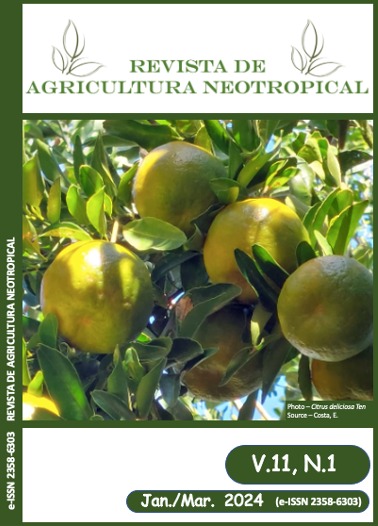Adubação de plantio e inoculação de Metarhizium anisopliae no crescimento inicial da cana-de-açúcar
DOI:
https://doi.org/10.32404/rean.v11i1.7712Palavras-chave:
Fungos entomopatogênicos, Fertilizantes, Microorganismos promotores de crescimento de plantasResumo
O objetivo do estudo foi avaliar a interação de doses da adubação de plantio (N:P:K) com a inoculação do fungo Metahizium anisopliae em toletes de cana-de-açúcar no desenvolvimento inicial da planta. O experimento foi conduzido em vasos, colocados a céu aberto, em esquema fatorial 2 x 5, assim especificado: com e sem inoculação do fungo nos toletes e cinco doses de adubação NPK (0%, 50%, 75%; 100% e 125% da adubação recomendada). Foi realizada a mensuração da altura de planta aos 53, 77 e 91 dias após o plantio (DAP) e quantificada da matéria seca (MS) da raiz e parte aérea aos 91 DAP. Para todos as vaiáveis analisadas, não houve diferença significativa para interação inoculação do fungo com as doses de adubação NPK (P>0,05). Entretanto, foi observada diferença significativa para a inoculação (P<0,05) e as doses de adubos NPK <0,05). Sendo que a inoculação de M. anisopliae resultou em maior altura de plantas, maior MS de raiz e da parte aérea em comparação com as plantas não inoculadas, independente das doses de adubação. Neste sentido, novos estudos devem ser realizados para viabilizar uma forma de redução de utilização de adubação NPK na cana-de-açúcar por meio da inoculação de M. anisopliae.
Referências
(I) Barrow, J.R., Osuna, P. 2002. Phosphorus solubilization and uptake by dark septate fungi in fourwing saltbush, Atriplex canescens (Pursh) Nutt. Journal of Arid Environments, 51(3), 449-459. DOI: https://doi.org/10.1006jare.2001.0925.
(II) Behie, S.W., Bidochka, M.J. 2014. Ubiquity of insect-derived nitrogen transfer to plants by endophytic insect-pathogenic fungi: an additional branch of the soil nitrogen cycle. Applied and Environmental Microbiology, 80(5), 1553-1560. DOI: https://doi.org/10.1128/AEM.03338-13.
(III) Behie, S.W., Zelisko, P.M., Bidochka, M.J. 2012. Endophytic insect-parasitic fungi translocate nitrogen directly from insects to plants. Science, 336(6088), 1576-1577. DOI: https://doi.org/10.1126/science.1222289.
(IV) Bose, A.S.D., Keharia, H. 2013. Production of indole-3-acetic-acid (IAA) by the white rot fungus Pleurotus ostreatus under submerged condition of Jatropha seedcake. Mycology, 4(2), 103-111.DOI: https://doi.org/10.1080/21501203.2012.823891.
(V) Bettiol, W. 2011. Biopesticide Use and Research in Brazil. Outlooks on Pest Management, 22(6), 280-283. DOI: https://doi.org/10.1564/22dec10.
(VI) Castro, T., Mayerhofer, J., Enkerli, J., Eilenberg, J., Meyling, N.V., Moral, R.A., Demétrio, C.G.B., Delalibera Júnior, I. 2016. Persistence of Brazilian isolates of the entomopathogenic fungi Metarhizium anisopliae and M. robertsii in strawberry crop soil after soil drench application. Agriculture. Ecosystems and Environment, 233(3), 361-369. DOI: https://doi.org/10.1016/j.agee.2016.09.031
(VII) Chaudhary, P.J., Raghunandan, B.L., Patel, H.K., Mehta, P.V., Patel, N.B., South, B., Dave, A., Bagul, S.Y., Divya, M., Jain, D., Alsahli, A.A., Kaushik, P. 2023. Growth-Promoting Potential of Entomopathogenic Fungus Metarhizium pinghaense AAUBC-M26 under Elevated Salt Stress in Tomato. Agronomy, 13(6), 1577-1599. DOI: https://doi.org/10.3390/agronomy13061577.
(VIII) CONAB. COMPANHIA NACIONAL DE ABASTECIMENTO. 2023. Acompanhamento de safra brasileira: cana-de-açúcar, primeiro levantamento, abril de 2023. https://www.conab.gov.br/info-agro/safras/cana/boletim-da-safra-de-cana-de-acucar. (acessado 04 de julho de 2023).
(IX) Elena, G.J., Beatriz, P.J., Alejandro, P., Roberto E, L. 2011. Metarhizium anisopliae (Metschnikoff) Sorokin Promotes Growth and Has Endophytic Activity in Tomato Plants. Advances in Biological Research, 5(1), 22-27. https://www.idosi.org/abr/5(1)/3.pdf.
(X) Elser, J.J., Bracken, E.S., Cleland, E.E., Gruner, D.S., Harpole, W.S., Hillebrand, H., Ngai,J.T., Seabloon, E.W., Shurin, J.B., Smith, J.E. 2007. Global analysis of nitrogen and phosphorus limitation of primary producers in freshwater, marine and terrestrial ecosystems. Ecology Letters, 10(12), 1135-1142. DOI: https://doi.org/10.1111/j.1461-0248.2007.01113.x.
(XI) Jaber L.R., Enkerli J. 2017. Fungal entomopathogens as endophytes: can they promote plant growth? Biocontrol Science and Technology, 27(1), 28–41. DOI: https://doi.org/10.1080/09583157.2016.1243227.
(XII) Krell, V., Unger, S., Jakobs-Schoenwandt, D., Patel, A.V. 2018. Endophytic Metarhizium brunneum mitigates nutrient deficits in potato and improves plant productivity and vitality. Fungal Ecology, 34, 43-49. DOI: https://doi.org/10.1016/j.funeco.2018.04.002.
(XIII) Lacey, L.A., Grzywacz, D., Shapiro-Ilan, D.I., Frutos, R., Brownbridge, M., Goettel, M.S. 2015. Insect pathogens as biological control agents: back to the future. Revista of invertebrate pathology, 132, 1-41. DOI: https://doi.org/10.1016/j.jip.2015.07.009.
(XIV) Oliveira, D.G.P., Pauli, G., Mascarin, G.M., Delalibera, I. 2015. A protocol for determination of conidial viability of the fungal entomopathogens Beauveria bassiana and Metarhizium anisopliae from commercial products. Journal of Microbiological Methods, 119, 44-52. DOI: https://doi.org/10.1016/j.mimet.2015.09.021.
(XV) R. Development Core Team. 2023. R: A language and environment for statistical computing. R Foundation for Statistical Computing, Vienna, Austria.
(XVI) Sasan, R.K., Bidochka, M.J. 2012. The insect-pathogenic fungus Metarhizium robertsii (Clavicipitaceae) is also an endophyte that stimulates plant root development. American Journal of Botany, 99(1), 101-107. DOI: https://doi.org/10.3732/ajb.1100136.
(XVII) Stone, L.B.L., Bidochka, M.J. 2020. The multifunctional lifestyles of Metarhizium: evolution and applications. Applied Microbiology and Biotechnology, 104(23), 9935-9945. DOI: https://doi.org/10.1007/s00253-020-10968-3.
(XVIII) Tall ,S., Meyling N.V. 2018. Probiotics for Plants? Growth Promotion by the Entomopathogenic Fungus Beauveria bassiana Depends on Nutrient Availability. Microbial Ecology, 76(1), 1002–1008. DOI: https://doi.org/10.1007/s00248-018-1180-6.
(XIX) Vega F.E., 2018. The use of fungal entomopathogens as endophytes in biological control: a review. Mycologia, 110(1), 4-30. DOI: https://doi.org/10.1080/00275514.2017.1418578.
Downloads
Publicado
Como Citar
Edição
Seção
Licença

Este trabalho está licenciado sob uma licença Creative Commons Attribution 4.0 International License.
Os autores mantêm os direitos dos artigos e, portanto, são livres para compartilhar, copiar, distribuir, executar e comunicar publicamente o trabalho sob as seguintes condições:
Reconheça os créditos do trabalho da maneira especificada pelo autor ou licenciante (mas não de uma maneira que sugira que você tenha o apoio deles ou que eles apoiem o uso do trabalho deles).
JOURNAL OF NEOTROPICAL AGRICULTURE - Revista de Agricultura Neotropical (ISSN 2358-6303) está sob licença https://creativecommons.org/licenses/by/4.0/
A Universidade Estadual de Mato Grosso do Sul, Centro de Desenvolvimento Sustentável do Bolsão Sul-Mato-grossense (CEDESU), da Unidade Universitária de Cassilândia (UUC) conserva os direitos patrimoniais (direitos autorais) das obras publicadas e favorece e permite a sua reutilização sob a licença supracitada.
------------
A revista se reserva o direito de efetuar, nos originais, alterações de ordem normativa, ortográfica e gramatical, com vistas a manter o padrão culto da língua, respeitando, porém, o estilo dos autores.
A provas finais serão enviadas aos autores.
Os trabalhos publicados passam a ser propriedade da revista. As opiniões emitidas pelos autores dos artigos são de sua exclusiva responsabilidade.


